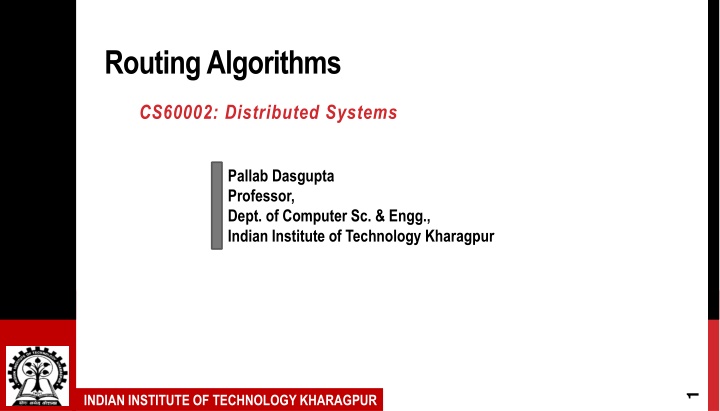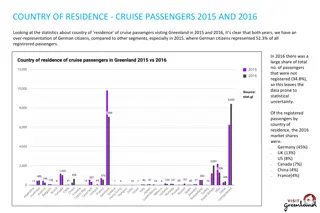
Advanced Routing Algorithms and Performance Optimization
Explore the intricacies of routing algorithms in distributed systems, focusing on computation of routing tables, packet forwarding, and performance considerations such as correctness, complexity, efficiency, robustness, and fairness. Learn about optimizing path selection based on factors like minimum hop, shortest path, minimum delay/congestion, and robustness. Delve into destination-based forwarding techniques and the implementation of the Floyd-Warshall algorithm for network optimization.
Download Presentation

Please find below an Image/Link to download the presentation.
The content on the website is provided AS IS for your information and personal use only. It may not be sold, licensed, or shared on other websites without obtaining consent from the author. If you encounter any issues during the download, it is possible that the publisher has removed the file from their server.
You are allowed to download the files provided on this website for personal or commercial use, subject to the condition that they are used lawfully. All files are the property of their respective owners.
The content on the website is provided AS IS for your information and personal use only. It may not be sold, licensed, or shared on other websites without obtaining consent from the author.
E N D
Presentation Transcript
Routing Algorithms CS60002: Distributed Systems Pallab Dasgupta Professor, Dept. of Computer Sc. & Engg., Indian Institute of Technology Kharagpur 1 INDIAN INSTITUTE OF TECHNOLOGY KHARAGPUR
Main Features Table Computation The routing tables must be computed when the network is initialized and must be brought up-to-date if the topology of the network changes Packet Forwarding When a packet is to be sent through the network, it must be forwarded using the routing tables 2 INDIAN INSTITUTE OF TECHNOLOGY KHARAGPUR
Performance Issues Correctness : The algorithm must deliver every packet to its ultimate destination Complexity : The algorithm for the computation of the tables must use as few messages, time, and storage as possible Efficiency : The algorithm must send packets through good paths Robustness : In the case of a topological change, the algorithm updates the routing tables appropriately Fairness : The algorithm must provide service to every user in the same degree 3 INDIAN INSTITUTE OF TECHNOLOGY KHARAGPUR
Good paths Minimum hop: The cost of a path is the number of hops Shortest path: Each channel has a non-negative cost the path cost is the sum of the cost of the edges. Packets are routed along shortest paths. Minimum delay/congestion: The bandwidth of a path is the minimum among the bandwidths of the channels on that path. Most robust path: Given the probability of packet drops in each channel, packets are to be routed along the most reliable paths. 4 INDIAN INSTITUTE OF TECHNOLOGY KHARAGPUR
Destination-based Forwarding // A packet with destination d was received or generated at node u if d = u then deliver the packet locally else send the packet to table_lookupu(d) 5 INDIAN INSTITUTE OF TECHNOLOGY KHARAGPUR
Floyd-Warshall Algorithm begin S = ; forall u, v do if u = v then D[u, v] = 0 else if uv E then D[u, v] = wu,v else D[u, v] = ; while S V do // Loop invariant: u, v: D[u, v] = dS(u, v) begin pick w from V \ S; forall u V do forall v V do D[u, v] = min{ D[u, v], D[u, w] + D[w, v] } S = S U { w } end end 6 INDIAN INSTITUTE OF TECHNOLOGY KHARAGPUR
The simple distributed algorithm // For node u var Su : set of nodes; Du Nbu : array of weights; : array of nodes; begin Su = ; forall v V do if v = u then begin Du[v] = 0; Nbu[v] = udef end else if v Neighuthen begin Du[v] = wu,v; Nbu[v] = v end else begin Du[v] = ; Nbu[v] = udef end; 7 INDIAN INSTITUTE OF TECHNOLOGY KHARAGPUR
The simple distributed algorithm contd while Su V do end begin pick w from V \ Su; if u = w then broadcast the table Dw else receive the table Dw forall v V do if Du[w] + Dw[v] < Du[v] then begin Du[v] = Du[w] + Dw[v] ; Nbu[v] = Nbu[w] end ; Su = Su U { w } end // All nodes must pick the same w 8 INDIAN INSTITUTE OF TECHNOLOGY KHARAGPUR
Important property of the simple algorithm Let S and w be given and suppose that (1) for all u, Du[w] = dS(u, w) and (2) if dS(u, w) < and u w, then Nbu[w] is the first channel of a shortest S-path to w Then the directed graph Tw = (Vw, Ew), where (u Vw Du[w] < ) and (ux Ew ( u w Nbu[w] = x )) is a tree rooted towards w. 9 INDIAN INSTITUTE OF TECHNOLOGY KHARAGPUR
Touegs improvement Toueg s observation: A node u for which Du[w] = at the start of the w-pivot round does not change its tables during the w-pivot round. If Du[w] = then Du[w] + Dw[v] < Du[v] is false for every v. Consequently, only the nodes that belong to Tw need to receive w s table, and the broadcast operation can be done efficiently by sending the table Dw only via the channels that belong to the tree Tw 10 INDIAN INSTITUTE OF TECHNOLOGY KHARAGPUR
The Chandy-Misra Algorithm init ; init udef ; var Du[v0] : weight Nbu[v0] : node For node v0 only: Processing a mydist, v0, d message from neighbor w by u: { mydist, v0, d Mwu } begin receive mydist, v0, d from w ; if d + uw < Du[v0] then begin Du[v0] = d + uw; Nbu[v0] = w ; forall x Neighu do send mydist, v0, Du[v0] to x end end begin Dv0[v0] = 0 ; end forall w Neighv0 do send mydist, v0, 0 to w 11 INDIAN INSTITUTE OF TECHNOLOGY KHARAGPUR
The Netchange Algorithm Computes routing tables according to minimum-hop measure Assumptions: N1: The nodes know the size of the network (N) N2: The channels satisfy the FIFO assumption N3: Nodes are notified of failures and repairs of their adjacent channels N4: The cost of a path equals the number of channels in the path Requirements: R1. If the topology of the network remains constant after a finite number of topological changes, then the algorithm terminates after a finite number of steps. R2. When the algorithm terminates, the tables Nbu[v] satisfy (a) if v = u then Nbu[v] = local ; (b) if a path from u to v u exists then Nbu[v] = w, where w is the first neighbor of u on a shortest path from u to v ; (c) if no path from u to v exists then Nbu[v] = udef. 12 INDIAN INSTITUTE OF TECHNOLOGY KHARAGPUR
The Netchange Algorithm var Neighu : set of nodes ; Du : array of 0 .. N ; Nbu : array of nodes ; ndisu : array of 0 .. N ; // The neighbors of u // Du[v] estimates d(u,v) // Nbu[v] is preferred neighbor for v // ndisu[w, v] estimates d(w,v) Initialization: begin forall w Neighu, v V do ndisu[w, v] = N ; forall v V do begin Du[v] = N ; Nbu[v] = udef end ; Du[u] = 0 ; Nbu[u] = local ; forall w Neighu do send mydist, u, 0 to w end 13 INDIAN INSTITUTE OF TECHNOLOGY KHARAGPUR
The Netchange Algorithm contd. Procedure Recompute( v ): begin if v = u end then begin Du[v] = 0 ; Nbu[v] = local end else begin // estimate distance to v d = 1 + min{ ndisu[w,v] : w Neighu } ; if d < N then begin Du[v] = d ; Nbu[v] = w with 1 + ndisu[w,v] = d end else begin Du[v] = N ; Nbu[v] = udef end end ; if Du[v] has changed then forall x Neighu do send mydist, v, Du[v] to x 14 INDIAN INSTITUTE OF TECHNOLOGY KHARAGPUR
The Netchange Algorithm contd. Processing a mydist, v, d message from neighbor w: { A mydist, v, d is at the head of Qwv } begin receive mydist, v, d from w ; ndisu[w,v] = d ; Recompute( v ) end Upon failure of channel uw: begin receive fail, w ; Neighu = Neighu\ {w} ; forall v V do Recompute( v ) end Upon repair of channel uw: begin receive repair, w ; Neighu = NeighuU {w} ; forall v V do begin ndisu[w,v] = N ; end end send mydist, v, Du[v] to w 15 INDIAN INSTITUTE OF TECHNOLOGY KHARAGPUR
Example Let us observe how this network comes up. Node Initialization: NeighA = {B,D} NeighB = {A,E} NeighC = {F} NeighD = {A,E} NeighE = {B,D,F} NeighF = {C,E} A B C D E F ndisu [w,v] = N for all w in Neighu V = {A, B, C, D, E, F} <mydist, A, 0> <mydist, B, 0> Du [v] = N (shown as - ), Nbu [v] = udef , for all v in V DA [A] = DB [B] = DC [C] = DD [D] = DE [E] = DF [F] = 0 NbA [A] = NbB [B] = NbC [C] = NbD [D] = NbE [E] = NbF [F]= local Every node u sends <mydist, u, 0> to all its neighbors. A B E <mydist, B, 0> <mydist, E, 0> 16
Example After first exchange of messages- ROUND-1 A B C D E F A B C D E F A B C D E F A B C D E F A B C D E F A B C D E F A B C D E F B - 0 - - - - A 0 - - - - - A 0 - - - - - B - - - 0 - - - - C - - 0 - - - - - - 0 - - 0 - - - F - - - - - 0 D F D - - - 0 - - E - - - - 0 - E - - - - 0 - E - - - - 0 - Recomputing for each message 1 DA 0 1 - 1 - - D 1 0 - - 1 - DC - - 0 - - 1 DD - - 0 1 - DE - 1 - 1 0 1 DF - - 1 - 1 0 B N NA l B u D u u A I u u E u NC u u l u u F ND A u u l E u NE u B u D l F NF u u C u E l B A B C D E F A B C D E F A B C D E F A B C D E F A B C D E F A B C D E F A B C D E F B 1 0 - - 1 - A 0 1 - 1 - - A 0 1 - - - B 1 0 - - 1 - C D 1 - - 0 1 - 1 0 1 F - 1 - - 0 - - 1 F - - 1 - 1 0 D 1 - - 0 1 - E - 1 - 1 0 1 E - 1 - E - 1 - 1 0 1 - 1 - 1 0
Example ROUND 2: A B C D E F A B C D E F A B C D E F A B C D E F A B C D E F A B C D E F A B C D E F B 1 0 - - 1 - A 0 1 - 1 - - A 0 1 - 1 - B 1 D 1 0 1 - 0 - - 1 - C - - 0 1 - - 1 - 1 0 - - 0 - - 1 F - - 1 - 1 0 D 1 - - 0 1 - E - 1 - 1 0 1 E - 1 - 1 E - 1 - 1 0 1 F - Recomputing for each message 1 DA 0 1 - 1 2 - D 1 0 - 2 1 2 DC - - 0 - 2 1 DD 2 - 0 1 2 DE 2 1 2 1 0 1 DF - 2 1 2 1 0 B N NA l B u D B u A I u A E E NC u u l u F F ND A A u l E E NE B B F D l F NF u E C E E l B A B C D E F A B C D E F A B C D E F A B C D E F A B C D E F A B C D E F A B C D E F B 1 0 - 2 1 2 A 0 1 - 1 2 - A 0 1 - 1 2 - B 1 0 - 2 1 2 C D 1 2 - 0 1 2 1 0 1 F - - - 0 - 2 1 F - 2 1 2 1 0 D 1 2 - 0 1 2 E 2 1 2 1 0 1 E 2 1 2 E 2 1 2 1 0 1 2 1 2 1 0
Example ROUND 3: A B C D E F A B C D E F A B C D E F A B C D E F A B C D E F A B C D E F A B C D E F B 1 0 - 2 1 2 A 0 1 - 1 2 - A 0 1 - 1 2 - B 1 0 - 2 1 2 C 2 - 0 1 2 2 1 2 1 0 - - 0 - 2 1 F - 2 1 2 1 0 D 1 F D 1 2 - 0 1 2 E 2 1 2 1 0 1 E 2 1 2 1 0 1 E 2 1 2 1 0 1 - Recomputing for each message 1 DA 0 1 - 1 2 3 D 1 0 3 2 1 2 DC - 3 0 3 2 1 DD 2 3 0 1 2 DE 2 1 2 1 0 1 DF 3 2 1 2 1 0 B N NA l B u D B B A I E A E E NC u F l F F F ND A A E l E E NE B B F D l F NF E E C E E l B A B C D E F A B C D E F A B C D E F A B C D E F A B C D E F A B C D E F A B C D E F B 1 0 3 2 1 2 A 0 1 - 1 2 3 A 0 1 - 1 2 3 B 1 0 3 2 1 2 C D 1 2 3 0 1 2 1 0 1 F 3 2 1 2 1 0 - 3 0 3 2 1 F 3 2 1 2 1 0 D 1 2 3 0 1 2 E 2 1 2 1 0 1 E 2 1 2 E 2 1 2 1 0 1
Example ROUND 4: A B C D E F A B C D E F A B C D E F A B C D E F A B C D E F A B C D E F A B C D E F B 1 0 3 2 1 2 A 0 1 - 1 2 3 A 0 1 - 1 2 3 B 1 0 3 2 1 2 C 2 3 0 1 2 2 1 2 1 0 - 3 0 3 2 1 F 3 2 1 2 1 0 D 1 F D 1 2 3 0 1 2 E 2 1 2 1 0 1 E 2 1 2 1 0 1 E 2 1 2 1 0 1 3 Recomputing for each message 1 DA 0 1 4 1 2 3 D 1 0 3 2 1 2 DC 4 3 0 3 2 1 DD 2 3 0 1 2 DE 2 1 2 1 0 1 DF 3 2 1 2 1 0 B N NA l B B D B B A I E A E E NC F F l F F F ND A A E l E E NE B B F D l F NF E E C E E l B A B C D E F A B C D E F A B C D E F A B C D E F A B C D E F A B C D E F A B C D E F B 1 0 3 2 1 2 A 0 1 - 1 2 3 A 0 1 - 1 2 3 B 1 0 3 2 1 2 C D 1 2 3 0 1 2 1 0 1 F 3 2 1 2 1 0 - 3 0 3 2 1 F 3 2 1 2 1 0 D 1 2 3 0 1 2 E 2 1 2 1 0 1 E 2 1 2 E 2 1 2 1 0 1
Example ROUND 5: A B C D E F A B C D E F A B C D E F A B C D E F A B C D E F A B C D E F A B C D E F B 1 0 3 2 1 2 A 0 1 4 1 2 3 A 0 1 4 1 2 3 B 1 0 3 2 1 2 C 4 3 0 3 2 1 D 1 2 3 0 1 2 1 0 1 F 3 2 1 2 1 0 F 3 2 1 2 1 0 D 1 2 3 0 1 2 E 2 1 2 1 0 1 E 2 1 2 E 2 1 2 1 0 1
Routing with Compact Routing Tables The algorithms studied require each node to maintain a routing table with an entry for each possible destination. How many destinations can there be? Is there a way to reorganize the routing tables and still remember which channel caters to which destinations? Indexing the routing table by channel. Each channel of the node has an entry informing which destinations must be routed via that channel. 22 INDIAN INSTITUTE OF TECHNOLOGY KHARAGPUR
Tree-Labeling Scheme ZN= { 0, 1, , N-1 } Cyclic Intervals The cyclic interval [a,b) in ZN is the set of integers defined by: {a,a+1, , b-1} {0, ,b-1,a, , N-1} if a b if a<b [a, b) = [a,a) = ZN The compliment of [a,b) is [b,a) when a b The cyclic interval [a,b) is called linear if a < b. 23 INDIAN INSTITUTE OF TECHNOLOGY KHARAGPUR
Tree-Labeling Scheme The nodes of a tree T can be numbered such that v0 l lvo = 0 For each outgoing channel of each node, the set of destinations that must be routed via that channel is a cyclic interval. w w' Let v0 be the root of the tree. For each node w let T[w] denote the subtree of T rooted at w l lw l lw = l lw + |T[w]| T[w] Number the nodes in the tree such that for each w the numbers assigned to the nodes in T[w] form a linear interval. l lx = l lw + |T[w]| - 1 x Let [aw, bw) denote the interval assigned to nodes in T[w]. Node w forwards to a son u packets with destinations in T[u], with labels in [au, bu) Node w forwards to a father packets with destinations not in T[u], with labels in ZN\ [aw, bw) = [bw, aw) 24 INDIAN INSTITUTE OF TECHNOLOGY KHARAGPUR
Tree-Labeling Scheme Procedure for Interval Forwarding (for node u): if d = lu then deliver the packet locally else begin end ; Representing a single interval requires 2 log N bits A node u has many intervals at the node. Only the start point of the interval for a channel is stored; the end point being the next begin point of an interval at the same node. At node u, the begin point of the interval for channel uw is given by: select i s.t d [ i , i+1 ]; send packet via the channel labeled with i lw if w is a son of u lu + |T[u]| if w is the father of u uw= 25 INDIAN INSTITUTE OF TECHNOLOGY KHARAGPUR
















